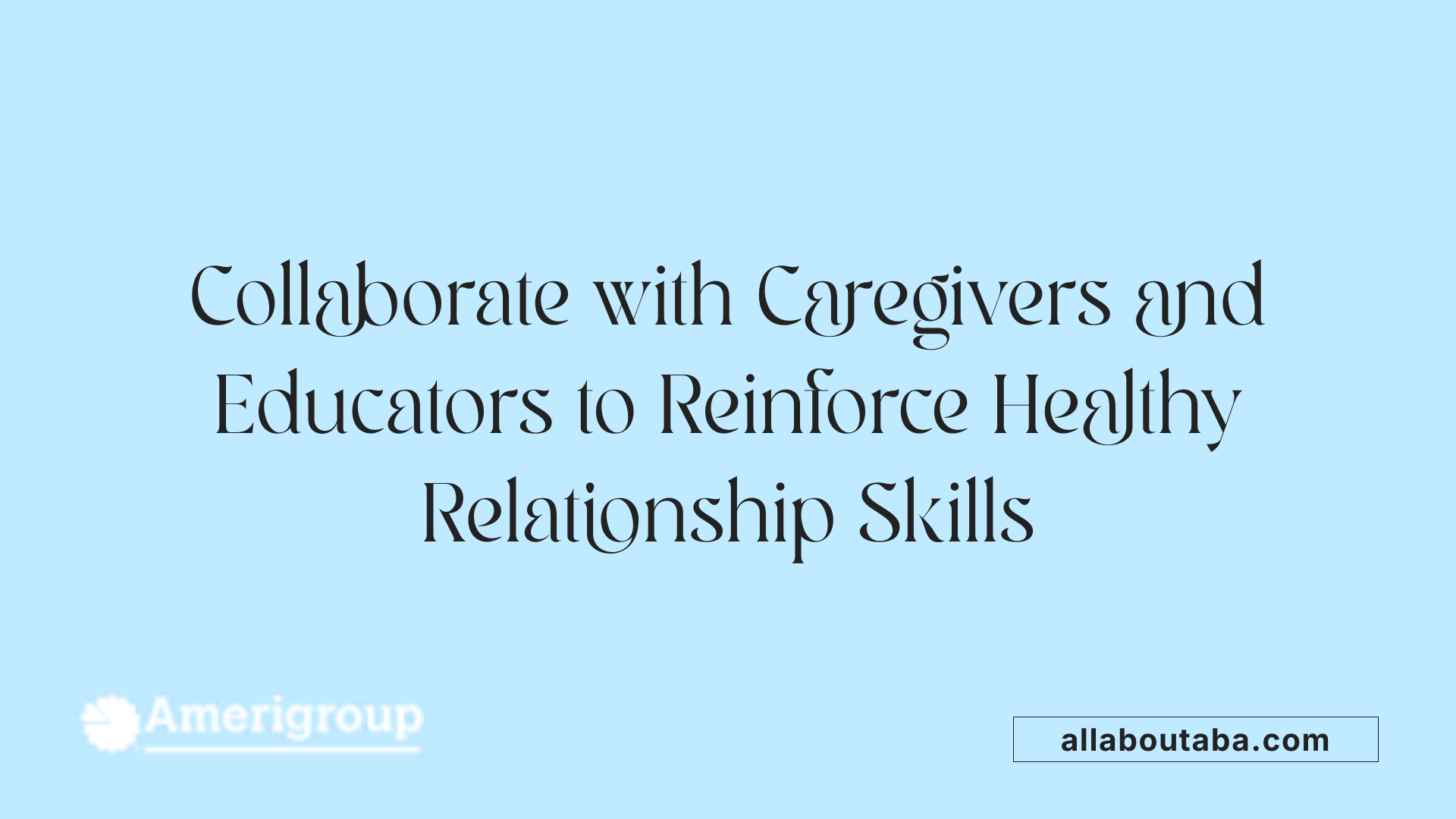How To Teach Autistic Teens About Healthy Relationships
Understanding the Foundations of Healthy Relationships for Autistic Youth
Teaching autistic teens about healthy relationships requires a nuanced approach that emphasizes safety, communication, and social understanding. These young individuals often face unique challenges in social interaction and understanding social cues, making targeted education and supportive environments essential. By integrating evidence-based programs, accessible resources, and family and school involvement, caregivers can foster confidence, respect, and safety in relationships, helping autistic teens navigate the complexities of romance and friendship.
Approaches for Teaching Boundaries and Relationship Safety

What are effective approaches for teaching autistic teens about boundaries and healthy relationships?
Teaching autistic teens about boundaries and how to navigate relationships involves a mix of specialized programs, visual tools, role-play, and support from caregivers and educators.
One effective method is participation in structured social skills training programs such as HEARTS, which are designed with input from autistic individuals. These programs focus on strengths-based learning and respect neurodiverse perspectives, making the lessons more relevant and accessible.
Visual aids are particularly helpful. For example, using a traffic-light system to identify relationship signals—red flags (warnings), amber flags (caution), and green flags (safe and positive behaviors)—helps teens recognize signs of unhealthy or healthy interactions quickly.
Role-playing and case scenarios are practical strategies that allow autistic teens to practice responses to real-life situations. These activities help clarify concepts like consent, personal space, and boundaries, making them easier to understand and remember.
Providing accessible, autism-friendly resources supports ongoing learning. Easy-read guides and testimonials from autistic adults create relatable, understandable content that emphasizes respect, safety, and self-awareness.
Involving parents, teachers, and caregivers in this educational process ensures consistency and reinforcement. When these adults deliver respectful, clear instruction about relationship boundaries and safety, autistic teens gain a stronger foundation for making safe, confident choices in their relationships.
By combining structured programs, visual supports, interactive scenarios, and collaborative teaching, we can equip autistic teens with the skills they need to build healthy, respectful bonds while recognizing and avoiding potential risks.
Supporting Self-Confidence and Positive Attitudes Towards Dating

What resources are available to help autistic teens build self-confidence and healthy attitudes towards dating?
Autistic teens can benefit greatly from a variety of tailored resources aimed at fostering self-confidence and positive perspectives on dating. Specialized social skills training programs, such as the UCLA PEERS curriculum, teach essential skills like making friends, understanding social cues, and developing romantic relationships. These programs employ evidence-based methods, including role-playing, video modeling, and behavioral rehearsal, which help teens learn and practice new social behaviors safely.
Counseling services and peer support groups also play a crucial role in creating a supportive environment where autistic teens can share experiences, receive encouragement, and learn from others facing similar challenges. Many organizations offer free webinars focusing on safe social media use, navigating sexuality, and handling rejection—providing accessible, expert insights tailored to autistic individuals.
An autism-specific healthy dating curriculum has been developed for teens aged 14 to 18, emphasizing practical knowledge about relationships, boundaries, and safety. These curricula are designed to be engaging and educational, making complex topics understandable.
Family involvement and community-based support are vital, with role-playing scenarios and social narratives helping reinforce learning and build confidence. Campaigns that promote authenticity and self-acceptance encourage teens to embrace who they are, boosting self-esteem.
Overall, combining skill development, safety education, and positive reinforcement helps autistic teens develop healthy attitudes about dating. Focused resources and supportive environments empower them to form meaningful, respectful relationships while respecting their individual strengths and needs.
Evidence-Based Social Skills Programs Focused on Relationships
Are there specific social skills training programs available for autistic teens that focus on relationships?
Yes, there are several programs tailored to help autistic teens develop healthy relationship skills. One of the most well-known is the PEERS (Program for the Education and Enrichment of Relational Skills) curriculum developed at UCLA. This program is evidence-based and designed to teach adolescents and young adults social skills such as making and keeping friends, understanding social cues, and managing peer rejection and conflicts.
PEERS includes various components like structured social skills groups, role-playing scenarios, and homework exercises that reinforce learning. The program emphasizes natural environment teaching, allowing teens to practice skills in real-world settings. It also involves parent coaching to help extend these skills at home and in the community.
Beyond PEERS, other interventions incorporate social stories, visual supports, and video modeling to help teens recognize appropriate social behaviors, understand boundaries, and navigate online relationships safely. These tools help clarify complex social concepts and provide visual cues that are easier for autistic teens to understand and remember.
Goals of social skills training in relationships
The main aim of these programs is to improve overall social competence and self-confidence. By better understanding social norms, teens learn to form genuine friendships and romantic connections while avoiding risky situations like cyberbullying or exploitation.
Specific goals include recognizing social cues, setting and respecting boundaries, engaging in reciprocal conversations, and managing feelings associated with rejection or rejection. Teaching about online safety and how to handle rejection is also a significant focus.
Handling cyberbullying and peer rejection
Cyberbullying is a common challenge for autistic teens who often favor online communication methods. Programs like PEERS teach strategies for recognizing cyberbullying, responding appropriately, and seeking help from trusted adults. They promote resilience by teaching teens to interpret social signals accurately and to maintain their self-esteem.
Parent involvement in training
Parents play a vital role. Many programs involve coaching sessions to help parents reinforce skills at home, facilitate peer interactions, and support their teens’ social growth. Active parent participation ensures consistency, provides additional practice opportunities, and helps problem-solve challenges as they arise.
Overall, these targeted social skills training programs, combining structured lessons, visual supports, and family involvement, significantly support autistic teens in building meaningful relationships and navigating social environments confidently.
Guidelines for Developing Social and Interpersonal Skills
What general guidelines can help autistic teens develop social and interpersonal skills necessary for healthy relationships?
Supporting autistic teens in building strong social and interpersonal skills calls for a structured and multifaceted approach. One effective method involves combining behavioral and developmental strategies, such as Applied Behavior Analysis (ABA) and social pragmatics, which focus on teaching social rules, cues, and reciprocity.
Visual supports, including social stories, cue cards, and diagrammatic aids, serve as helpful tools for conveying social expectations and understanding body language. Role-playing exercises and social narratives allow teens to practice real-life interactions in a safe environment, helping them become more familiar with social norms and expectations.
Modeling appropriate social behaviors through peer demonstration is also crucial. Peer mentoring and structured group activities promote natural social engagement, fostering peer support and encouragement.
Creating safe and supportive social environments is fundamental. This can involve setting up in-school clubs, community groups, or online forums where teens can practice social skills without undue pressure.
Involving parents and caregivers is essential for reinforcing learning at home. Providing them with strategies to practice social skills, discuss social dilemmas, and give positive feedback enhances consistent skill development.
Tailoring these approaches to each individual's needs and abilities ensures more effective results. Overall, fostering a positive, understanding, and patient environment helps autistic teens develop lasting relationships and social confidence.
Supporting Education and Open Conversations About Relationships
How can parents and educators facilitate conversations about sexuality and relationships with autistic teens?
Engaging autistic teenagers in discussions about sexuality and relationships requires creating a supportive, honest environment where they feel safe to ask questions and share concerns. This begins with open, ongoing dialogue that treats these topics as natural parts of development.
Structured education plans, such as Education, Health, and Care Plans (EHCPs), can include tailored modules on personal boundaries, consent, and social skills education. Using visual supports like social stories, diagrams, and videos helps make abstract concepts concrete and easier to understand.
Explicit instruction on topics such as personal space, safe touching, and recognizing social and physical cues is essential. Practice through real-life scenario role-plays enables teens to apply knowledge practically, boosting confidence and competence.
Key topics should be approached incrementally, starting early and progressing as the teen matures. Addressing sensitive subjects such as masturbation, privacy, and LGBTQ+ identities should be done with patience and clarity.
Collaborating with healthcare professionals, teachers, and support staff ensures consistent messages and access to comprehensive, inclusive education.
Ultimately, fostering a respectful, non-judgmental atmosphere encourages autistic teens to develop healthy attitudes towards relationships. Equipping them with social tools like assertiveness, understanding rejection, and interpreting social cues helps them navigate social interactions safely and confidently.
By combining visual aids, practical scenarios, and honest communication, parents and educators can empower autistic teens with the knowledge and skills they need to form meaningful, healthy relationships.
Preventing Unhealthy Relationships and Bullying
How can caregivers identify and prevent unhealthy relationships or bullying among autistic teens?
Caregivers play a vital role in helping autistic teenagers navigate complex social environments and protect them from potential harm. To identify unhealthy relationships, adults should look for signs such as withdrawal from friends, sudden mood changes, reluctance to go to school or social events, or unusual behaviors that may indicate discomfort or distress.
Preventing bullying involves proactive education. Teaching teens to recognize warning signs like being excluded, receiving mean comments, or experiencing physical or cyber abuse is essential. Role-playing scenarios and social scripts can help teens practice assertiveness and self-advocacy, empowering them to set boundaries and speak up when something feels wrong.
Creating an inclusive environment through awareness campaigns and peer support programs encourages respect and understanding. Schools and community groups can implement initiatives that promote autism acceptance and reduce stigma, making peers more supportive.
Open communication is crucial. Regular discussions about feelings, experiences, and social situations foster trust and enable teens to share concerns early. Staff training and clear anti-bullying policies in schools ensure a safer setting.
Finally, teaching teens about trustworthy relationships—highlighting the importance of mutual respect, consent, and personal boundaries—helps them recognize and seek healthy connections. When teens are equipped with this knowledge, early intervention becomes possible, reducing the risk of exploitation or abuse.
Empowering a Supportive and Informed Approach
Educators, parents, and caregivers play pivotal roles in fostering understanding, confidence, and safety among autistic teens. By implementing evidence-based programs, promoting open dialogue, and providing accessible resources, they can equip young people with the skills necessary to build healthy, respectful, and safe relationships. Recognizing the unique social challenges faced by autistic individuals and addressing them through tailored education and supportive environments creates a foundation where autistic teens can thrive socially and romantically, embracing their authenticity and forming meaningful connections.
References
- An Autistic Guide to Healthy Relationships
- Helping Your Autistic Teen Build Healthy Relationships
- Autism relationships: Dating as an autistic teen
- Teaching Relationship Skills to Autistic Children and Young Adults
- Autistic young people create guide to relationships and intimacy
- Love and Dating Resources - Autism Research Institute
- Mike's Crush - The Dibble Institute
- [PDF] Supporting Teens with Autism to learn about Romantic Relationships
Other articles
Recent articles

Best Practices For Autism-Friendly Fitness And Recreation Centers

Best Ways To Promote Healthy Social Media Use For Autistic Teens

How To Help Autistic Children Cope With Public Speaking

Autism And Strategies For Managing Unexpected Changes

Best Podcasts About Autism For Parents And Educators

Autism And The Impact Of Seasonal Changes On Behavior

The Role Of Diet In Managing Co-Occurring Conditions With Autism

Sleep Challenges In Autism And Practical Solutions

Best Ways To Build Daily Routines For Autistic Children

Best Practices For Supporting Autistic Entrepreneurs

Autism And Strategies For Navigating Large Social Gatherings

Adaptive Sports And Recreational Activities For People With Autism

Autism And The Benefits Of Story-Based Learning Activities

Understanding The Role Of Play In Autism Development

Autism And The Impact Of Environmental Noise On Learning

How To Create Autism-Friendly Community Spaces

Autism And Chronic Health Conditions: What To Know

The Role Of Care Managers In Autism Life Planning

How To Teach Social Boundaries To Autistic Children

How Autistic Individuals Experience Empathy Differently

How To Support Autistic Employees In Remote Work Settings

Autism And The Relationship Between Motor Skills And Learning

How To Create Community Resource Guides For Autism Families

How To Teach Daily Living Skills To Autistic Teens

Autism And The Impact Of Mind-Body Practices On Stress Reduction

Autism And The Benefits Of Outdoor Group Activities

How To Create Autism-Friendly Sensory Paths In Schools

Best Practices For Autism-Friendly Park And Recreation Areas

Autism And Strategies For Reducing School Refusal

Supporting Autistic Individuals In Public Speaking

The Role Of Diet In Managing Autism Symptoms

The Benefits Of Gardening Clubs For Autism Social Development

How To Prepare Autistic Children For Dental Visits

Autism And Employment: Career Paths That Work

Best Practices For Autism-Friendly Hotels And Lodging

The Impact Of Screen Time On Autism Development

Autism Screening Tools For Early Childhood

The Role Of Physical Exercise In Autism Therapy

Best Strategies For Supporting Autistic College Students

The Role Of Technology In Autism Early Detection

Sensory-Friendly Classroom Design Ideas For Autistic Students

The Role Of Speech Therapy In Building Social Communication Skills

Best Strategies For Handling Autistic Burnout In Adults

Autism And The Importance Of Predictability In Routine

Autism And Peer Education: Teaching Acceptance In Schools

Best Practices For Sensory-Friendly Libraries And Reading Rooms

Self-Advocacy Skills For Autistic Adults

The Role Of Technology In Autism Peer Communication

Promoting Physical Activity In Children With Autism

How To Prepare Autistic Children For Medical Procedures

The Role Of Social Media In Autism Advocacy And Awareness

The Impact Of Sensory Rooms In Public Facilities For Autism

How To Create An Autism-Friendly Holiday Celebration

Best Practices For Inclusive Education For Autistic Students

Autism And Mental Health: Recognizing Signs Of Distress

Best Practices For Sensory-Friendly Waiting Rooms

The Role Of Teachers In Early Autism Red Flag Identification

Autism-Friendly Housing Design Features

Autism-Friendly Housing Design Features

How Environmental Modifications Improve Autism Outcomes

Autism And Technology-Based Learning Tools

Supporting Autistic Children Through Changes In Routine

The Link Between Autism And Working Memory Challenges

Best Practices For Autism-Friendly Cooking Classes

Autism And The Benefits Of Structured Music Lessons

Best Books To Teach Kids About Autism Acceptance

Sensory Diets And Their Benefits For Autism Management

How To Prepare Autistic Teens For Driver’s Education

How To Teach Autistic Teens About Healthy Relationships

The Role Of Visual Prompts In Building Daily Habits For Autism

Addressing Sleep Regression In Children With Autism

Understanding Social Stories And How They Help Autistic Children

Navigating Insurance Coverage For Autism Therapy Services

How To Prepare Autistic Adults For Independent Travel

Supporting Autistic Individuals In Volunteer Work

How Mindfulness Practices Can Support Autism Well-Being

Understanding Hyperfocus And Special Interests In Autism

Understanding Stimming As A Self-Regulation Tool

Sensory-Based Interventions For Autism At Home

Best Ways To Introduce Self-Advocacy In Autistic Teens

Best Ways To Support Autistic Employees In Customer Service Roles

Best Practices For Autism-Friendly Volunteer Programs

Autism And The Benefits Of Sensory Play For Emotional Growth

Autism And Strategies For Building Peer Relationships

Understanding How Autism Affects Memory Processing

Autism And Strategies For Building Coping Skills In Teens

The Role Of Parent Training In Autism Intervention Programs

Autism-Friendly Workplace Accommodations

Using Visual Timers For Autism Time Management

What Is ABA Therapy?

Autism and Sleep

Do Plastic Toys Cause Autism?

Autism Facial Expressions

Autism and Motor Skills

Which Parent Carries The Autism Gene?

Autism Symbols & Colors

Rett Syndrome: Symptoms, Causes, and Treatment

Self-Diagnosed Autism

Autism and Sound Sensitivity

Autism With Speech Delay
We’re All About You, Your Family, and Your Child

